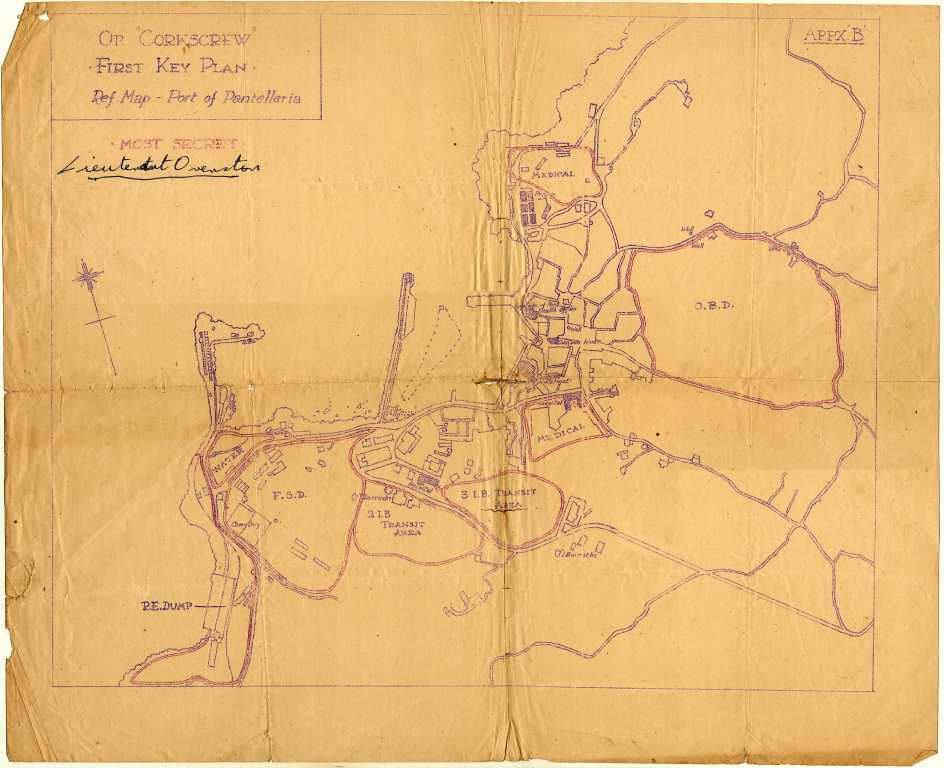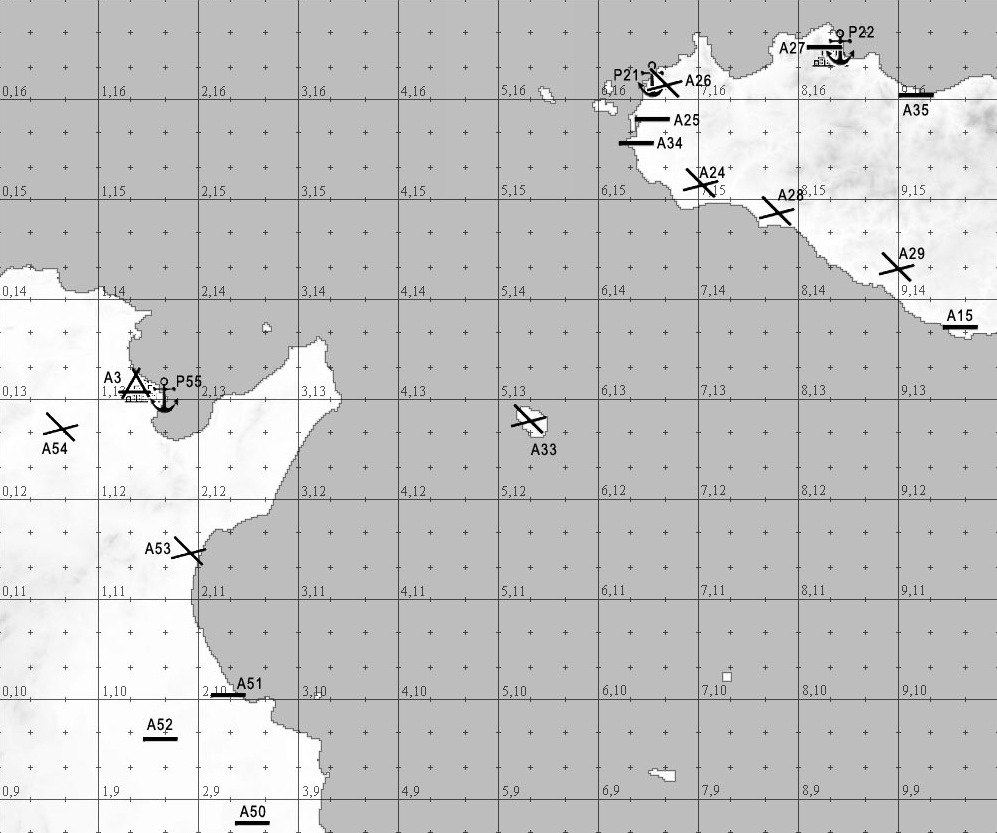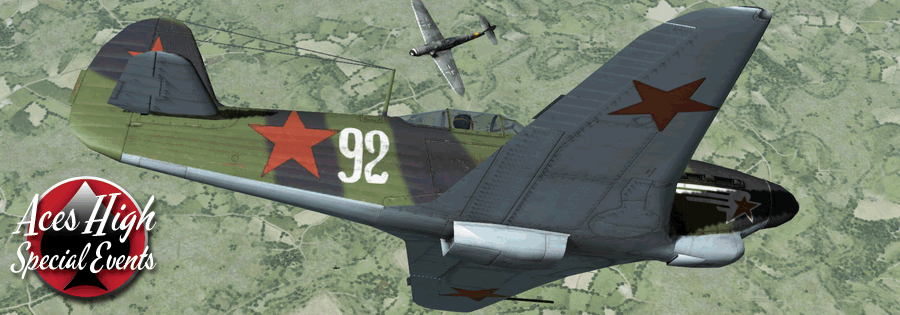Pantelleria 1943

Introduction
Operation Corkscrew was the code name for the Allied invasion of the Italian island of Pantelleria (between Sicily and Tunisia) on 11 June 1943, prior to the Allied invasion of Sicily during the Second World War. There had been an early plan to occupy the island in late 1940 (Operation Workshop),[but this was aborted when the Luftwaffe strengthened the Axis air threat in the region.
The Allied focus returned to Pantelleria in early 1943. The radar installations and airfield on the island were seen as a real threat to the planned invasion of Sicily (codenamed Operation Husky). The Italian garrison on the island was 12,000 strong in well-entrenched pillboxes and 21 gun batteries of a variety of calibers. In addition, there was an opportunity to assess the impact of bombardment upon heavily fortified defenses. It was decided to see if the island could be forced into submission by aerial and naval bombardment alone. Failing this, an amphibious invasion was planned for 11 June.
Starting in late May, the island was subjected to steadily increasing bombing attacks. In early June, the attacks intensified and 14,203 bombs amounting to 4,119 tons were dropped on 16 Italian batteries. On 8 June, a Royal Navy task force of five cruisers, eight destroyers and three torpedo boats carried out a bombardment of the main port on the island.
The engagement was observed by General Dwight D. Eisenhower, the Supreme Allied Commander in the Mediterranean, and Admiral Andrew Cunningham from the flagship HMS Aurora. From 8 May to 11 June 5,285 bombing sorties were flown by fighter-bombers, medium and heavy bombers, dropping a total of 6,202 tons of bombs on the island.
Two demands for the garrison to surrender went unanswered and, on 11 June, the amphibious assault went ahead. About an hour before the landing craft reached the beaches, the accompanying ships opened fire. Unknown to the attackers, the commander of the garrison on Pantelleria had sought permission to surrender from Rome the previous evening and received it that morning.[3] When the first of the British Commandos landed, the Italians surrendered. The British Prime Minister, Winston Churchill, was to record later in his memoirs that the only British casualty of the operation was a man bitten by a mule.
An assessment by British analyst Professor Sir Solly Zuckerman reported that the defenses had been reduced to 47 percent effectiveness. The intense ten-day air bombardment had substantially reduced the defenses. Out of 80 guns bombed, 43 were damaged (10 beyond repair). All control communications were destroyed, along with many gun emplacements, ammunition stores and air-raid shelters. The ease of the operation led to an optimistic assessment of the effectiveness of bombing, which was not always borne out in practice.
The Italian garrisons on other nearby islands (Lampedusa and Linosa) quickly fell. This cleared the way for the invasion of Sicily a month later.
Please join the FSO Team for this mid years war special event featuring the USAAF vs the Luftwaffe in Pantelleria 1943.
Side Split
Axis 50%
Allies 50%
Planeset
|
Axis |
Allies |
||||
|
Aircraft |
Min - Max |
location |
Aircraft |
Min - Max |
location |
|
Macchi 202 |
Unlimited |
A33 |
P-40F |
Unlimited |
A51 |
|
Macchi 205 |
Max 6 |
A33 |
P-38G |
Max 36 |
A54 |
|
BF109G-2 |
Max 36 |
A29 |
Spitfire IX |
Max 18 |
A3 |
|
BF109G-6 |
Max 12 |
A25 |
B-26B |
Min 6 |
A53 |
|
JU88A-4 |
Min 12 |
A24 |
B-25C |
Min 6 |
A3 |
Ordnance Distribution
Axis
JU88A-4 - Ext. [2x] or [4x] 250 kg bombs, Int. 20 kg bombs or [2x] F5B Torpedoes
Allies
B-26B - Int. [8x] 500 lb. bombs
B-25C- Int. [6x] 500 lb. bombs
Terrain

Special Event Rules and Ordnance Restrictions
- This is a one life event. Pilots may not re-plane at their home or other airfields.
- Ordnance for each aircraft will be set by the setup CM in the hangar.
- Aircraft may rearm and refuel at any friendly base. Aircraft should be landed before frame’s end at any friendly base.
- All assaults must be made by no less than 12 attacking aircraft.
- All destroyed objects stay down for the entire frame.
- All Hangars, Cruisers and Destroyers will have the same destruction weight of 2800 lbs.
- The Aircraft carriers will be removed from any target fleets.
- All bomber aircraft will be restricted to an altitude not exceed 18k.
- Fighter aircraft may not attack ground targets.
- The Allies may control the stirring of their fleet within the assign cruise area.
Targets and Scoring
Allied Targets = [4] Bomber Hangars [3] Fighter Hangars [1] Vehicle Hangar
Axis Targets = [2] Cruisers and [6] Destroyers
Single Engine Fighter - 1 pt.
Multi-Engine Bomber - 2 pts.
Hangars =10 pts.
Ships = 10 pts.
Arena Settings
- Terrainmap: Malta
- Fuel burn rate: 1.0
- Anti-aircraft gun strength: 0.5
- Bombsight calibration: AUTOMATIC (MA standard)
- Icons: 3.0K yards (9,000 feet)
- Sector Radar ("bar dar"): OFF
- Dot Radar: OFF
- Fighter and Bomber warning range: 26,400 feet (5 miles)
- Tower range set to 26,400 feet (for display only, to match the above setting)
- Haze range: 12 miles
- Friendlycollisions: OFF
- Enemy collisions: ON
- Kill shooter: OFF
- Stall Limiter: Set ON (Players may disable)
Wind:
Altitude Speed Direction
00 - 02K 0 NO WIND
02 - 10K 05 W -> E
10 - 18K 13 W -> E
18 - 26K 27 W -> E
26 - 30K 38 W -> E
30K+ -199 DOWNDRAFT
Arena Clock:
Frame 1 05:45 (7:00 AM, Morning)
Frame 2 11:00 (11:00 AM, Morning)
Frame 3 14:00 (3:00 PM, Afternoon)
ACE MISSIONS
Each side will have one mandatory Ace mission per frame. These frames will represent notable pilots of the time and theater. One pilot from each side will be designated an "Ace" Pilot. They must fly the Aces listed aircraft. The Aces must be relayed to the Admin CM before launch. They will be scored as follows.
Ace Pilot = 20 Points (Opponent Score)
Ace Pilot Kills = 20 Points
So for example if an Ace Pilot is shot down they are worth 20 points to the other side. Like wise, every victory an Ace Pilot lands they will be rewarded 20 points.
Axis
Frame 1 - BF109G-6 Oberleutnant Ernst Wilhelm Reinert, Staffwlkaptain 1./JG 77 – Emerging as the top-scoring pilot of the Tunisian campaign Reinert achived 51 kills from January to April of 1943. His G-6 wore the Geschwader badge, introduced in April 1943, which gave the unit its name of JG 77 ‘Herz-As’(Ace of Hearts). By war’s end Hauptmann Reinert was in charge of IV/JG27 and had scored 174 aerial kills with an additional 16 on the ground.
Frame 2 – BF109G-2 Feldwebel Anton Hafner 4./JG 51 – Hafner had already scored 62 kills in Russia before reporting to /JG 51 in Sardinia. He added an additional 20 kills to his record in the Mediterranean. Shortly there after being commissioned and officer of the Luftwaffe and reported to III. /JG 51 on the Eastern Front. He was killed in action over East Prussia on 17 June 1944 in a dogfight at low altitude with a Yak-9. Despite being lost almost a year before the end of the war, Hafner’s outstanding score of 204 kills was never exceeded by another /JG 51 pilot.
Frame 3 – C205 Segenta Maggiore Luigi Gorinni 3◦ Stormo - was an Italian World War II fighter pilot in the Regia Aeronautica and in the Aeronautica Nazionale Repubblicana. During the conflict he flew with the Corpo Aereo Italiano (CAI, Italian Air Corps) during the Battle of Britain, fought over Libya and Tunisia, and was involved in the defence of the Italian mainland. Gorrini was credited with 19 (24 according to some sources) enemy planes shot down plus 9 damaged, of several types: Curtiss P-40, Spitfire, P-38 Lightning, P-47 Thunderbolt, B-17 "Flying Fortress" and B-24 Liberator. He claimed his air victories flying the biplane Fiat C.R.42 and monoplanes Macchi C.202 and C.205 Veltro. Gorrini was the top scoring C.205 pilot. With the Veltro he shot down 14 enemy planes and damaged six more.[1] He was the highest ranking Italian ace still alive until his death, and the only surviving fighter pilot awarded the Medaglia d'Oro al Valor Militare (Gold Medal of Military Valor).
Allies
Frame 1 – P-40F Lt. Colonel Hershel “Herky†Green 325th FG - Green served with the 317th FS, 325th Fighter Group, 15th AF. Top ace of the "Checkertail Clan" with 18 air victories, (3 in P-40s, 10 in P-47s, 5 in P-51s), plus 10 destroyed on the ground. Total Combat Sorties: 100.
On August 17, 1943, the Allies captured Sicily, leaving no targets for the 325th except for some Italian forces on Sardinia, against which the Group began bombing missions with their P-40s. Knowing that the Italians on Sardinia were nearly at the end of their resources, and imagining headlines like "FIGHTER GROUP CAPTURES ENEMY ARMY," the 325th dropped surrender demands to the Italian commander on Sardinia. (He apparently resisted these, and eventually surrendered to regular Allied ground armies.)
Frame 2 – P-38G Lt. “Ricky†Zubarik 82nd FG – By May 13 1943 Zubarik had become an ace scoring his 6th kill on the 21st of May. Lt. Zubarik’s P-38G named Pearl III had donned 6 swastikas for his six kills. It also had donned 2 question marks as the Lt. was caught up in a dogfight with two ME 410s that collided into his Lightning. He did not receive credit for those aircraft and two day later Lt. Zubarik was shot down over Sardinia and made a POW.
Frame 3 – Spitfire IX Wing Commander Lance Cleo "Wildcat" Wade DSO, DFC & Two Bars (1915 – 12 January 1944) was an American pilot who joined the Royal Air Force (RAF) during World War II and became a flying ace. He remained with RAF until his death in a flying accident in 1944 in Italy. In 30 fights for which he made claims he was credited with 23 victories (including two shared), one probable, and 13 damaged.
Designer Notes:
Designed by – AKWarHwk August 2017
